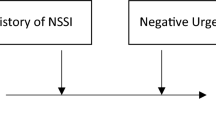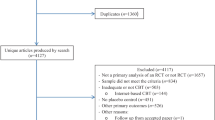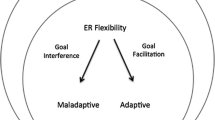Abstract
Forty-five individuals with generalized anxiety (38 with GAD as defined by DSM-III) were randomized to 4 treatment conditions or a waiting list control. Patients received 8 sessions of either frontal EMG biofeedback, biofeedback to increase EEG alpha, biofeedback to decrease EEG alpha, or a pseudomeditation control condition. All treated subjects showed significant reductions in STAI-Trait Anxiety and psychophysiologic symptoms on the Psychosomatic Symptom Checklist. Only alpha-increase biofeedback subjects showed significant reductions in heart rate reactivity to stressors at a separate psychophysiological testing session. Decreased self-report of anxiety was maintained at 6 weeks posttreatment.
Similar content being viewed by others
References
American Psychiatric Association (1978).Diagnostic and statistical manual of mental disorders, 3rd Edition, Washington, DC: American Psychiatric Association.
American Psychiatric Association, Committee on Nomenclature and Statistics (1987).Diagnostic and statistical manual of mental disorders, 3rd Edition, Revised. Washington, DC: American Psychiatric Association.
Attanasio, V., Andrasik, F., Blanchard, E. B., & Arena, J. G. (1984). Psychometric properties of the SUNY Revision of the Psychosomatic Symptom Checklist.Journal of Behavioral Medicine, 7, 245–259.
Barlow, D. H., Blanchard, E. B., Vermilyea, J. A., Vermilyea, B. B., & DiNardo, P. A. (1986). Generalized anxiety and generalized anxiety disorder: Description and reconceptualization.American Journal of Psychiatry, 143, 40–44.
Barlow, D. H., Cohen, A. S., Waddell, M. T., Vermilyea, B. B., Klosko, J. S., Blanchard, E. B., & DiNardo, P. A. (1984). Panic and generalized anxiety disorders: Nature and treatment.Behavior Therapy, 15, 431–449.
Barlow, D. H., Craske, M. G., Cerny, J. A., & Klosko, J. S. (1989). Behavioral treatment of panic disorder.Behavior Therapy.20, 261–282.
Barlow, D. H., Vermilyea, J., Blanchard, E. B., Vermilyea, B. B., DiNardo, P. A., & Cerny, J. A. (1985). The phenomenon of panic.Journal of Abnormal Psychology, 94, 320–328.
Beck, A. T., & Emery, G. (1985).Anxiety disorders and phobia: A cognitive perspective. New York: Basic Books.
Blowers, C., Cobb, J., & Mathews, A. (1987). Generalized anxiety: A control treatment study.Behaviour Research and Therapy, 25, 493–502.
Borkovec, T. D., & Matthews, A. M. (1988). Treatment of non-phobic anxiety disorders: A comparison of non-directive, cognitive, and coping desensitization therapy.Journal of consulting and Clinical Psychology, 56, 877–884.
Clark, D. (1986). A cognitive approach to panic.Behaviour Research and Therapy, 24, 461–470.
Dahlstrom, W. G., & Welsh, G. S. (1960).An MMPI handbook: A guide to use in clinical practice and research. Minneapolis, University of Minnesota Press.
Hardt, J. V., & Kamiya, J. (1978). Anxiety change through electroencephalographic alpha feedback seen only in high anxiety subjects.Science, 201, 79–81.
Holroyd, K. A., Andrasik, F., & Noble, J. (1980). Comparison of EMG biofeedback in a credible pseudo therapy in treatment tension headache.Journal of Behavioral Medicine, 3, 29–39.
Plotkin, W. B. (1976). On the self-regulation of the occipital alpha rhythm: Control strategies, states of consciousness, and the role of physiological feedback.Journal of Experimental Psychology: General, 105, 66–99.
Plotkin, W. B., & Rice, K. M. (1981). Biofeedback as a placebo: Anxiety reduction facilitated by training in either suppression or enhancement of alpha brain waves.Journal of Consulting and Clinical Psychology, 49, 590–596.
Rachman, S. (1988). Panics and their consequences: Review and prospect. In S. Rachman and J. Maser (Eds.),Panic: Psychological perspectives. Hillsdale, NJ: Lawrence Erlbaum.
Rachman, S., & Levitt, K. (1985). Panics and their consequences.Behaviour Research and Therapy, 23, 585–600.
Rice, K. M., & Blanchard, E. B. (1982). Biofeedback in the treatment of anxiety disorders.Clinical Psychology Review, 2, 557–577.
Spielberger, C. D., Gorsuch, R. L., & Lushene, R. E. (1970).STAI manual for the State-Trait Anxiety Inventory. Palo Alto, CA: Consulting Psychologists Press.
Author information
Authors and Affiliations
Rights and permissions
About this article
Cite this article
Rice, K.M., Blanchard, E.B. & Purcell, M. Biofeedback treatments of generalized anxiety disorder: Preliminary results. Biofeedback and Self-Regulation 18, 93–105 (1993). https://doi.org/10.1007/BF01848110
Issue Date:
DOI: https://doi.org/10.1007/BF01848110




